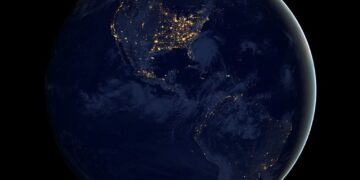The cosmos never ceases to amaze, and the recent discovery of the K2-360 planetary system is no exception. This system, located about 750 light-years from Earth, is home to two fascinating planets: an ultra-dense “super-Earth,” K2-360 b, and a massive outer companion, K2-360 c.
An Overview of the K2-360 System
The K2-360 system stands out for its two planets’ intriguing features. K2-360 b, a super-Earth, orbits its sun-like star in just 21 hours—earning it the title of an ultra-short period planet. At 1.6 times the size of Earth but 7.7 times its mass, K2-360 b is as dense as lead, making it the densest well-characterized planet in its category. Meanwhile, K2-360 c, an outer companion planet with at least 15 Earth masses, completes its orbit in 9.8 days. Together, these planets offer a unique laboratory for studying planetary dynamics and the processes that govern their formation.
K2-360 b: The Ultra-Dense Super-Earth
K2-360 b’s extreme density sets it apart from other planets in its class. Packing nearly eight Earth masses into a volume only slightly larger than our planet, it defies conventional expectations. This extraordinary density suggests that K2-360 b may be the stripped core of a much larger planet that lost its outer layers due to intense stellar radiation.
Its composition is particularly intriguing. Scientists estimate that K2-360 b has a substantial iron core, accounting for about 48% of its total mass, surrounded by a rocky mantle. This composition makes it more similar to Earth than Mercury, despite its extreme density. Given its proximity to its star, K2-360 b likely experiences scorching temperatures, leaving its surface molten or partially molten.
The Role of K2-360 c in System Dynamics
The presence of K2-360 c adds another layer of complexity to the system. Although this outer planet does not transit its star, its gravitational interactions with the host star and K2-360 b reveal its significant influence. Researchers propose that K2-360 c may have driven K2-360 b into its current tight orbit through a process known as high-eccentricity migration. This mechanism involves gravitational interactions that initially make the inner planet’s orbit highly elliptical. Over time, tidal forces circularize the orbit, leaving the planet in its ultra-short period configuration.
High-eccentricity migration challenges traditional theories of planetary migration, which often attribute the inward movement of planets to interactions with their natal gas disks. In the case of K2-360 b, the gravitational push from K2-360 c provides a compelling alternative explanation, highlighting the diverse pathways through which planets can evolve.
Implications for Planetary Formation Theories
The discovery of the K2-360 system poses significant challenges to existing theories of planetary formation and evolution. Ultra-short period planets like K2-360 b are relatively rare, and finding one with such an extreme density is even more unusual. The system’s architecture, featuring a dense inner planet and a massive outer companion, raises questions about the processes that shape planetary systems in extreme environments.
Theories suggest that close-in planets like K2-360 b may have originally formed farther from their stars, where temperatures allowed for the accumulation of volatile materials. Over time, gravitational interactions with other planets or the protoplanetary disk could have driven these planets inward. In the case of K2-360 b, its stripped core indicates that it may have once been a larger planet with a gaseous envelope, which was subsequently lost due to intense radiation from its host star.
How K2-360 Was Discovered
The discovery of K2-360 b and c is a testament to the power of modern astronomical techniques. NASA’s K2 mission, a follow-up to the Kepler mission, played a crucial role in detecting K2-360 b. By observing periodic dips in the star’s brightness as the planet transited, scientists were able to infer its size and orbital period.
Follow-up observations with ground-based telescopes provided additional data. Instruments like HARPS and HARPS-N, which measure the radial velocity of stars, revealed the presence of K2-360 c by detecting the subtle wobble it induces in the host star. These observations confirmed the planet’s minimum mass and hinted at its potential role in shaping the system’s dynamics.
Future Research Directions
The K2-360 system represents a promising target for future research. Advanced telescopes, such as the James Webb Space Telescope (JWST) and the Atacama Large Millimeter Array (ALMA), could provide deeper insights into the system’s characteristics. By studying the atmospheric composition of K2-360 b and investigating the orbital dynamics of K2-360 c, scientists hope to uncover more details about the processes that govern planetary evolution.
Understanding systems like K2-360 could also inform the search for exoplanets with similar characteristics. The extreme environments of ultra-short period planets offer valuable clues about the diversity of planetary systems and the factors that influence their development.
Conclusion
The K2-360 system is a shining example of the complexity and diversity of planetary systems in the universe. From the ultra-dense super-Earth K2-360 b to the massive outer companion K2-360 c, this system offers a wealth of opportunities for scientific exploration. Its unique characteristics challenge existing theories, inspire new models, and deepen our understanding of the processes that govern planetary formation and evolution.
Reference:
John H. Livingston et al, An ultra-short-period super-Earth with an extremely high density and an outer companion, Scientific Reports (2024). DOI: 10.1038/s41598-024-76490-y



















